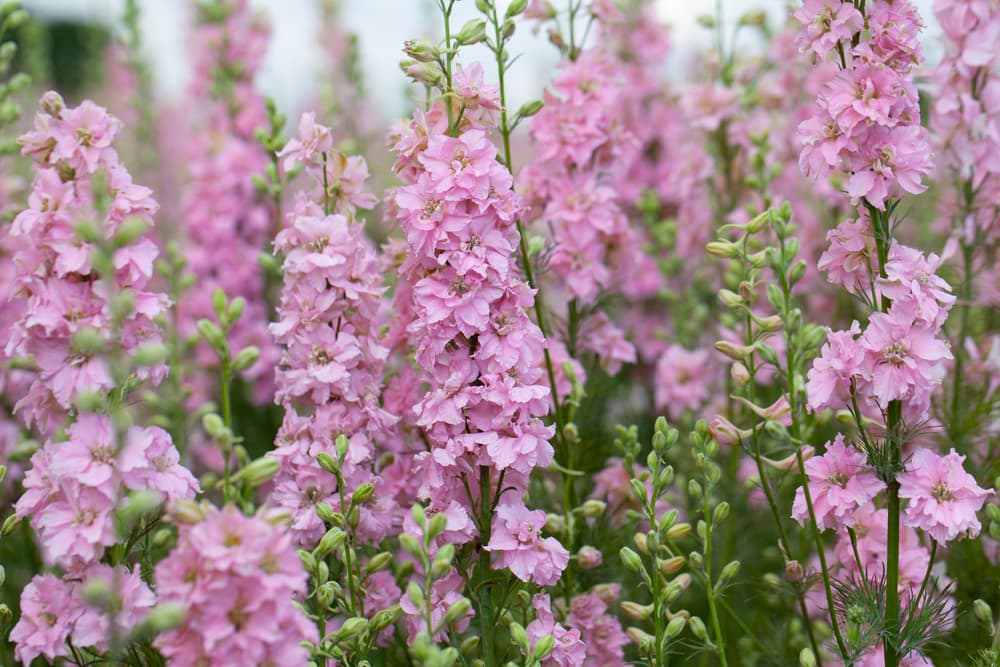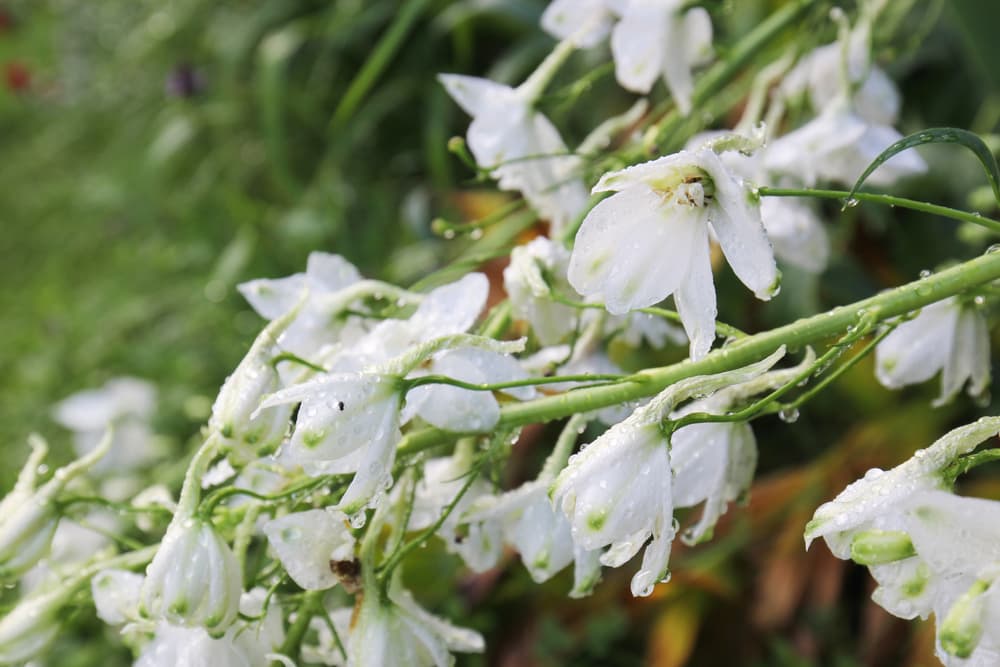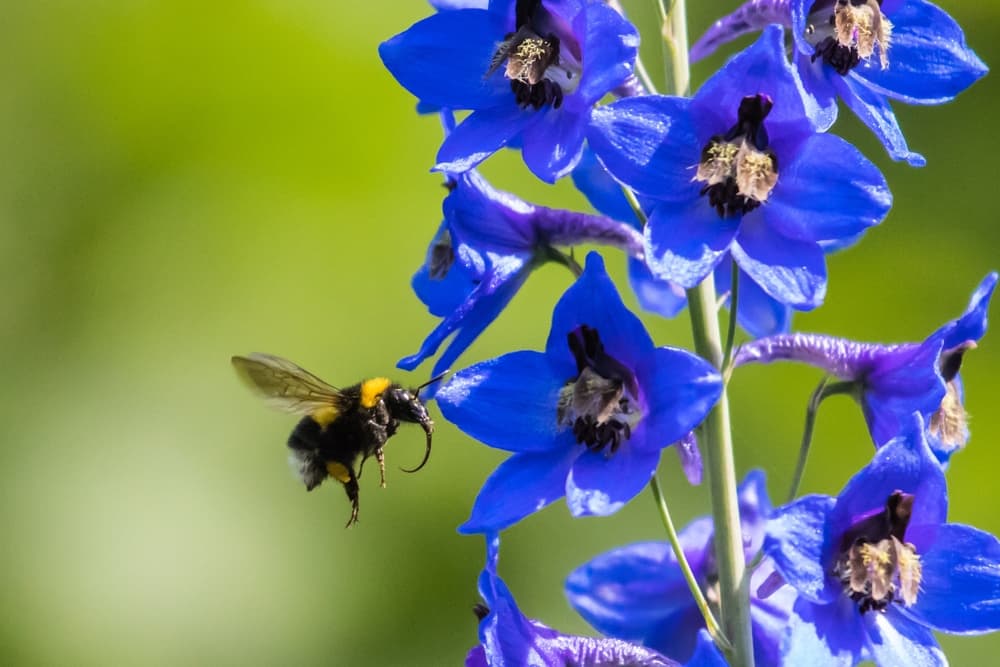PERENNIALS > DELPHINIUM
Reviewed By DAN ORI

Dan has over 27 years’ under his belt caring for plants and gardens. Working as a Horticultural Instructor and Consultant, he draws on a diverse range of experience that includes working as a Head Gardener, Tree Surgeon, Garden Centre Trouble Shooter, and writer of academic papers. Dan has a Level 3 Diploma in Horticulture and is currently a candidate for the RHS’s most prestigious award – The Master of Horticulture.
Contributions From GRAHAM AUSTIN

Graham Austin is a Delphinium expert and RHS 2022 Gold Medalist who is the owner of Home Farm Plants, a specialist plant nursery.
Delphinium, often called Larkspur, is a perennial plant bearing clusters of richly-hued flowers.
It is native to the Northern Hemisphere and is found in many settings, ranging from hilly meadows to well-tended flower beds.
This beautiful ornamental flower is not only fairly easy to grow, it brings both eye-catching colour and uncommon grace to a garden.
In crafting this guide we interviewed delphinium expert Graham Austin, the Owner of Home Farm Plants specialist nursery.
“Whilst training at a nursery, I was given the opportunity to check the delphiniums following their winter dormancy” explains Graham.
“I liked how their tall spikes stood out from other perennials and my interest grew from there”.
Overview
| Botanical Name | Delphinium |
| Common Name(s) | Larkspur |
| Plant Type | Perennial Flower / Annual Flower |
| Native Area | China |
| Hardiness Rating | H5 |
| Foliage | Palmately lobed basal leaves |
| Flowers | Showy flowers in spikes, racemes or panicles |
| When To Sow | March, April |
| Flowering Months | June, July, August, September |
| When To Prune | September, October |
Sunlight
Preferred
Full Sun
Exposure
Sheltered
Size
Height
1.5 – 2.5M
Spread
0.5 – 1M
Bloom Time
June – September
Soil
Preferred
Chalk, Loam, Sand
Moisture
Moist but well drained
pH
Any
The Delphinium plant comprises a stem or ‘spike’ varying in length from about ten centimetres to over two metres, depending on the species.
It has palmate leaves with well-defined lobes that are often pointed.
Even here one gets variety: depending on the species each leaf has from three to seven lobes.

Crowning the plant is a raceme of brilliantly-coloured flowers, closely clustered.
In nature, the colours range from light blue to deep purple, making the Delphinium one of the few flowers to occur naturally in true tones of blue.
Less common species and hybrids and cultivars come in many other colours including white, yellows and reds.

In the vast majority of species, the flower, as we see it, comprises not only of the petals proper but also the (coloured) sepals.
Five sepals – usually mistaken for petals – fan out within which four much smaller petals are set.
The top sepal projects a rearward spur as if to defend the pretty flower.
In many varieties, right in the centre of this delicate assembly is a decorative eye or ‘bee’ – a floral ‘beauty spot’.

The distinctively-shaped bud reputedly gave the plant its name: the bud reminds one of a dolphin’s head and the top petal’s trailing spur resembles a fish’s body, leading the Hellenes to christen the plant after the Greek word for dolphin – delphíni.1The Stories Behind 10 Flower Names. (2022, April 13). Merriam Webster. Retrieved March 15, 2023, from https://www.merriam-webster.com/words-at-play/10-flower-names-with-interesting-stories-behind-them
Stately and upright but swaying or even willowy in a breeze, and with a gamut of brilliant reds, purples, or blues colouring the floral crown, Delphiniums make the ideal backdrop to a garden.
In fact, this beautiful plant can be made the centrepiece of a garden.
How To Grow Delphinium
Soil Requirements
I would argue that the best type of soil for Delphinium is deep, loamy, and limey soil tending to the alkaline, though many types will grow perfectly well in neutral or acidic soils too.
Adding compost to even good soil will improve results by effecting richer, more intense, blooms.

If the soil’s pH is on the low side, some lime may be added to it.
Most critically, the soil must have very good drainage as undrained or even poorly-drained soil will cause root rot.
Aspect
The plant should get about seven hours of exposure to the sun.
Originally a native of hilly regions and climes, the Delphinium does best in relatively open spaces that are not very close to trees or solid man-made structures.
Given its flowering height, I find that blustery sites are unsuitable for Delphiniums; however, gentle breezes that cause it to sway not only pose any danger, but they will also enhance the beauty of this ornamental plant.

Delphinium thrives in cool and moist climates that drop to near freezing in the winter.
Transplanting
When transplanting Delphiniums, the root-ball should be just underneath the soil level.
Pack the plant tightly into the soil to ensure that no air-pockets exist around the roots, and water it in generously.
Delphinium plants should be spaced two or more feet apart.
Delphinium Care
Delphinium’s many species and types and the various zones they can be grown in make for a quite combination of factors; thus, there is no ‘one size fits all’ type of prescription.

Any care and growing tips recommendations should be taken as guidelines and the gardener should be encouraged to experiment within reasonable bounds.
For example, given the Delphinium type and the conditions (soil and zone), nutrients like wood ash or bone meal in varying quantities can be mixed into the soil in spring.
Feeding & Watering
Delphinium plants should be watered moderately three to four times per week.
Watering should be at soil level – avoid watering from above the plant to minimise the possibility of powdery mildew or even stem rot or crown rot from setting in.

Make sure that the water drains well as Delphiniums have a very low tolerance for waterlogged soil.
About once a month I sprinkle some 10-10-10 or all-purpose fertiliser around the stalk but do not push it into the soil.
“Delphiniums are heavy feeders, so give them general feed in the spring and just before flowering”, advises Graham.
“After pruning, give them another feed with general fertiliser to encourage a second autumn flowering”.
For English Delphinium varieties, use 12-12-12 fertiliser.
Mulching
Periodically mulch the plant during the flowering season by spreading a small amount of the plant’s own mulch at the base of each plant.
After autumn comes around and the flowers die, apply several inches of a heavier mulch at the roots.

At the end of winter, remember to clean out the mulch shortly before you expect spring frost otherwise there is a risk of stem rot.
Pruning
Trimming and thinning are very important for a Delphinium plant’s beauty and well-being.
After the plant’s first flowering of the season and just before summer, Graham Austin recommends that you trim most or all of the flower stalks – but not the rest of the crown – in between the lower-most flower and ground level.

This gardener’s trick will probably cause the plant to bloom once again in late summer or early autumn.
Cut spent flower spikes (deadhead them) down nearly to the ground or to the level of any emerging side shoots.
Annual thinning is of utmost importance as uncontrolled blooming may well cause the plant, especially cultivars and hybrids, to self-destruct.

Thin the shoots when they are four inches tall; leave two spikes for a one-year plant, three for a two-year plant, and so forth.
You can have five to seven spikes on mature plants and over 20 on eight-plus-year plants.
As for the plant’s stalks, every three or four years these can be dug up, divided into separate clumps and re-planted.
After the plant’s first frost, cut the stems down to ground level.
Some gardeners do so every year and, depending on the zone, climate, and type of Delphinium, this is good practice.
Common Problems
While some Delphinium varieties attract aphids, mites and leaf miners, the most common and main threat to this plant is from snails and slugs.
According to Graham: “Slugs are the main problem people seem to have. We recommend using horticultural grit in and around the plant (as the slugs don’t like the texture when crawling on it) and thinning the plant by taking out the weaker stems and only leaving the strongest.
“This lets the air circulate through the plant keeping it drier, therefore less slugs.
As another solution, “nematodes can also be used and work well from April onwards, once the weather is slightly warmer.”
“Nematodes species used to control slugs can be very effective when stored and applied correctly, and in my opinion, are the only effective control in borders, if you exclude slug pellets,” says Dan Ori, Master Horticulturist.
In the growing season, you can sprinkle red cayenne pepper on fresh young growth.
Propagation
You can multiply your Delphinium plants (or oblige your neighbours!) by selectively cutting stalks when they are shoots so as to plant and root them.
Buying potted young cuttings, as opposed to seeding Delphiniums, gives you a head start in growing them without the trouble associated with germinating them from seed.

Delphiniums can be grown from seeds. However, unlike many plants, Delphinium seeds start losing viability quite soon, from one to two years.
Seeds germinate best when planted in early spring or autumn, though they can be planted year-round.
Do not plant seeds of cultivars and most hybrids directly into a flower bed but plant them in pots or flats indoors.

On the other hand, you could also look to plant the seeds of naturally-occurring Delphiniums directly into a prepared flower bed.
References
- 1The Stories Behind 10 Flower Names. (2022, April 13). Merriam Webster. Retrieved March 15, 2023, from https://www.merriam-webster.com/words-at-play/10-flower-names-with-interesting-stories-behind-them


